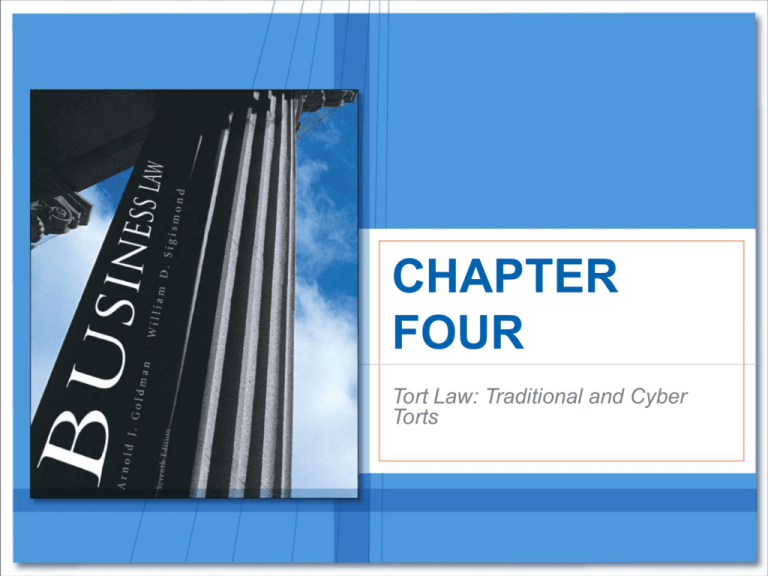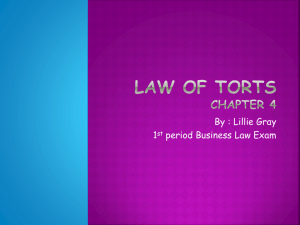
CHAPTER
FOUR
Tort Law: Traditional and Cyber
Torts
Tort Law
• Tort law is designed to protect people from
wrongful conduct where the violator is not
subject to criminal laws.
• Someone who commits a private wrong has
committed a tort. He/she is subject to a civil
lawsuit and will be required to compensate
the injured party.
• Often a wrongful act can be both a tort and a
crime.
Copyright © Houghton Mifflin Company. All rights reserved.
4|2
Classification of Torts
• Tort law is broken down into three broad
categories:
– Intentional Torts
– Negligence
– Strict Liability Torts
Copyright © Houghton Mifflin Company. All rights reserved.
4|3
Intentional Torts
• Intentional Torts – the defendant consciously
performed some act that personally injured the
plaintiff or the plaintiff’s property.
– The harm that results does not have to be intended. Only
that the act that caused the harm was performed
intentionally.
• Assault and Battery
– Assault: threatening act that makes a person apprehensive
of imminent harmful or offensive contact.
– Battery: actual harmful or offensive contact made with
another person without that person’s consent.
Copyright © Houghton Mifflin Company. All rights reserved.
4|4
Intentional Torts (continued)
• False Imprisonment: intentional confinement or restraint of
another person without justification by the use of or threat of
physical force.
– Merchant Exception: a merchant may detain a shoplifter
when the following three requirements are followed:
Reasonable Cause – to suspect shoplifting
Reasonable Manner – the detention is carried out in a
reasonable manner
Reasonable Time – the detention can last only a
reasonable time
Copyright © Houghton Mifflin Company. All rights reserved.
4|5
Intentional Torts (continued)
• Infliction of Mental Distress – intentional or
reckless behavior that is shocking and
outrageous and results in emotional injury to
the plaintiff.
• Must be more than an insult or conduct which makes the
person feel bad. Humiliation, embarrassment, indignities,
annoyance, or bad manners are not sufficient enough for
the requirements of this tort.
• The above standard can be very difficult to meet.
Copyright © Houghton Mifflin Company. All rights reserved.
4|6
Intentional Torts (continued)
• Defamation – false statement or writing, heard or
seen by a third person, which holds someone up to
contempt, ridicule, or hatred.
– Libel: written defamation
– Slander: spoken defamation
– Truth of the statements is an absolute defense against
defamation.
• To sustain defamation a public person must be able
to prove the statements or writings were made with
malice or reckless disregard for the facts.
Copyright © Houghton Mifflin Company. All rights reserved.
4|7
Intentional Torts (continued)
• Invasion of Privacy
– Using a person’s name or likeness for trade or
advertising purposes without that person’s prior
written approval.
– Can also be the right to be left alone.
• To live your life free of unauthorized publicity and
wrongful intrusion in your life by another person or the
government
– The right to have private areas of your life such as
medical and psychiatric care kept confidential.
Copyright © Houghton Mifflin Company. All rights reserved.
4|8
Intentional Torts (continued)
• Wrongful Death – a person who commits a wrongful
act that results in the death of another can be sued
for wrongful death.
• Malicious Prosecution – consists of series of
conditions a plaintiff must be able to prove:
– There were no grounds for the criminal or civil action.
– There was an intent to injure.
– The action was not successful.
Copyright © Houghton Mifflin Company. All rights reserved.
4|9
Intentional Torts (continued)
• Fraud – occurs when false statements are
deliberately made that deceive, resulting in injury or
loss to another.
• Interference with Contractual Relations – allows the
people whose contract is breached to sue a party
outside the contract whose actions induced one of
the people in the contract to breach the contract.
– Two related lawsuits here:
One against the person outside the contract who induced
the breach of contract; this is the tort suit.
One against the person in the contract for breach of
contract
Copyright © Houghton Mifflin Company. All rights reserved.
4 | 10
Intentional Torts (continued)
• Trespass – unlawful interference with
another’s possession of his/her real or
personal property.
• Conversion
– Is often considered to be the civil version of
larceny, or
– The civil version of receiving stolen property.
Copyright © Houghton Mifflin Company. All rights reserved.
4 | 11
Intentional Torts (continued)
• Nuisance – arises from a person who uses his
property unreasonably or unlawfully resulting in
discomfort or inconvenience to others.
– There is no general test for this tort, rather the court
considers what is the effect of the activity on a reasonable
person.
• Theft of Trade Secrets – when a person or business
unlawfully acquires trade secrets of another.
– The trade secret generally must be something that gives one
business an advantage over another.
Copyright © Houghton Mifflin Company. All rights reserved.
4 | 12
Negligence
• The law requires a plaintiff in a negligence
suit to show facts that satisfy the following
four criteria:
– The defendant had a legal duty to act carefully.
– The defendant breached the duty to act carefully.
– The defendant’s failure to act carefully proximately
caused the plaintiff’s injury.
– The defendant’s negligence caused the plaintiff to
suffer physical injury or damage.
Copyright © Houghton Mifflin Company. All rights reserved.
4 | 13
Negligence (continued)
• Defenses to negligence:
– Comparative Negligence: many states have
adopted a rule known as comparative negligence.
• Requires that the jury allocate the responsibility in an
accident to both the plaintiff and defendant.
• Most states will not allow a plaintiff who contributed more
than 50% to his or her own injury to collect damages.
– Contributory Negligence: some states say if the
plaintiff contributes in any way to his or her own
injury, the plaintiff will be barred from recovery.
Copyright © Houghton Mifflin Company. All rights reserved.
4 | 14
Strict Liability Torts
• The law recognizes that certain activities and
products present a high risk of harm to the
public.
• Thus, the law says that anyone who carries
on these high-risk activities will be held liable
for any harm caused to innocent victims.
Copyright © Houghton Mifflin Company. All rights reserved.
4 | 15
Tort Remedies
• The usual remedy for violations of tort law will
be money damages.
• Of course, before damages are paid for any
tort, the plaintiff bears the burden of proving
the damages.
• Punitive Damages – can be awarded where
the activity that led to harm is extreme and
the law believes there is need to present a
strong civil law deterrent.
Copyright © Houghton Mifflin Company. All rights reserved.
4 | 16


